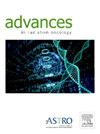Dosimetric Performance of Orthogonal Dual-Layer Multi-Leaf Collimator System on Locally Advanced Lung Cancer: Cardiac Substructures Sparing Plans
IF 2.7
Q3 ONCOLOGY
引用次数: 0
Abstract
Purpose
This study aims to reduce the risk of cardiovascular incidents and radiation pneumonia (RP) by improving the dose distribution to cardiac substructures through the use of a dual-layer multileaf collimator (MLC) accelerator- VenusX.
Methods and Materials
Eighteen patients with advanced-stage lung cancer were selected for this study. The total lung, spinal cord, whole heart, and specific cardiac substructures (including the left ventricle [LV], pulmonary artery, left anterior descending artery, left circumflex artery [LCX], and coronary artery) were delineated as organs at risk and incorporated into the optimization process of the avoidance plan. Single-layer MLC plans optimized for the whole heart, referred to as S-WH plans (where WH denotes whole heart), were developed alongside single-layer MLC plans specifically designed to avoid cardiac substructures, known as S-CS plans (where CS denotes cardiac substructures). Additionally, dual-layer MLC avoidance plans, designated as D-CS plans, were created for each patient. We evaluated the relative risk of coronary artery disease, chronic heart failure, acute cardiac events, and RP, as well as the effective dose to the immune system.
Results
D-CS plans significantly reduced the dose metrics of LV, pulmonary artery, left anterior descending artery, LCX, and the coronary, while maintaining target coverage and achieving comparable conformity index to the S-WH plans. Additionally, the D-CS plans significantly decreased the volume receiving 5 Gy (V5Gy) for the LV and V15Gy of LCX, with other substructures also experiencing a notable degree of dose reduction. Furthermore, the relative risk of coronary artery disease, chronic heart failure, acute cardiac event, and RP is ranked as follows: D-CS < S-CS < S-WH plans. Effective dose to the immune system of the D-CS plans indicated the lowest risk among the 3 plans.
Conclusions
The dual-layer MLC system demonstrated superior performance compared to the single-layer MLC system in CS-avoidance plans, providing new opportunities for subsequent immunotherapy in patients with locally advanced lung cancer.
正交双层多叶准直系统在局部晚期肺癌中的剂量学性能:心脏亚结构保留计划
目的本研究旨在通过使用双层多叶准直器(MLC)加速器- VenusX改善心脏亚结构的剂量分布,从而降低心血管事件和放射性肺炎(RP)的风险。方法与材料选择18例晚期肺癌患者作为研究对象。将全肺、脊髓、全心和特定的心脏亚结构(包括左心室[LV]、肺动脉、左前降支、左旋动脉[LCX]和冠状动脉)划分为危险器官,并纳入回避方案的优化过程。针对全心脏优化的单层MLC计划称为S-WH计划(WH表示全心脏),与专门设计避免心脏亚结构的单层MLC计划称为S-CS计划(CS表示心脏亚结构)一起开发。此外,为每位患者创建双层MLC避免计划,称为D-CS计划。我们评估了冠状动脉疾病、慢性心力衰竭、急性心脏事件和RP的相对风险,以及对免疫系统的有效剂量。结果d - cs方案显著降低左室、肺动脉、左前降支、LCX和冠状动脉的剂量指标,同时保持目标覆盖率,符合指标与S-WH方案相当。此外,D-CS方案显著降低lvx接受5gy (V5Gy)和V15Gy的体积,其他亚结构也经历了显著程度的剂量减少。此外,冠状动脉疾病、慢性心力衰竭、急性心脏事件和RP的相对危险度排序如下:D-CS <; S-CS <; S-WH计划。3种方案中,D-CS方案对免疫系统的有效剂量风险最低。结论双层MLC系统与单层MLC系统相比,在CS-avoidance方案中表现出更好的效果,为局部晚期肺癌患者的后续免疫治疗提供了新的机会。
本文章由计算机程序翻译,如有差异,请以英文原文为准。
求助全文
约1分钟内获得全文
求助全文
来源期刊

Advances in Radiation Oncology
Medicine-Radiology, Nuclear Medicine and Imaging
CiteScore
4.60
自引率
4.30%
发文量
208
审稿时长
98 days
期刊介绍:
The purpose of Advances is to provide information for clinicians who use radiation therapy by publishing: Clinical trial reports and reanalyses. Basic science original reports. Manuscripts examining health services research, comparative and cost effectiveness research, and systematic reviews. Case reports documenting unusual problems and solutions. High quality multi and single institutional series, as well as other novel retrospective hypothesis generating series. Timely critical reviews on important topics in radiation oncology, such as side effects. Articles reporting the natural history of disease and patterns of failure, particularly as they relate to treatment volume delineation. Articles on safety and quality in radiation therapy. Essays on clinical experience. Articles on practice transformation in radiation oncology, in particular: Aspects of health policy that may impact the future practice of radiation oncology. How information technology, such as data analytics and systems innovations, will change radiation oncology practice. Articles on imaging as they relate to radiation therapy treatment.
 求助内容:
求助内容: 应助结果提醒方式:
应助结果提醒方式:


